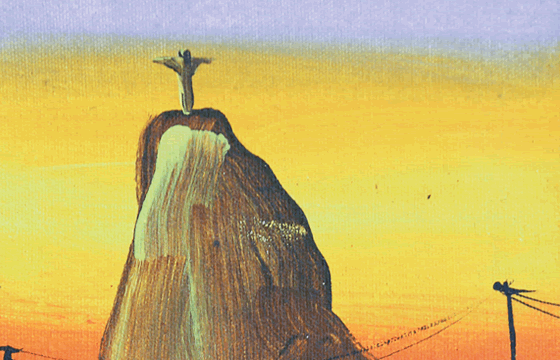
Not every painting needs to be famous. On my desk at work is an image that two dear friends brought back from Brazil when they went there for World Youth Day a few years ago. I can’t even tell you who the artist is: the work is signed simply Marcelo.
My friends found this man displaying his canvasses on a median strip in the middle of a major thoroughfare — it was a reminder that there are many parts of the world where every square inch is needed for people to make even a basic living. If traffic came to a standstill, as it often did, the artist could sell direct to the motorist. It was a bit like a drive-thru art gallery.
The picture is original but by no means unique. The artist seemed to churn out a considerable number of similar images of various shapes and sizes — something for every wallet. My particular version shows the iconic statue of Christ the Redeemer that, since 1922, has towered over the city of Rio de Janeiro where the picture was painted.
In reality, the statue is almost 40 metres tall. But in this picture it seems quite small, blending in with the colours of the mountain on which it is perched. It appears as part of the forest of telegraph poles growing in the haphazard settlements, known as favelas, at the foot of the mountain.
These impoverished suburbs spring up out of sheer necessity. The ageless mountain and the makeshift housing are painted in the same tones. The picture expresses a beautifully simple faith; it says to me that God is above and beyond us. At the same time, it suggests that God is as close to us as our own chaos. It reminds us that God has a special relationship with the poor.
One of the people who gave me the picture, Chris Straford, died in January this year at the age of just 55. I have been looking at the picture on an almost daily basis since then because both its vibrant energy and its warm compassion remind me of Chris. Chris was a friend of mine for 34 years; the last nine of which we worked together in the area of faith formation at St Kevin’s College, a large Edmund Rice school in Melbourne.
This is the most wonderful work with which to be entrusted — both mysterious and surprising. Chris was great at challenging young people to see the world through eyes of faith, prepared to work for justice. Everyone dreams of having such a generous and unselfish colleague. He had a passionate relationship with scripture and with the Jewish tradition from which it grew. He loved the mystery and wonder of sacred texts and was frustrated by people for whom the Gospel was reduced to a few clichés or slogans.
The students loved Chris and all his eccentricities. Some of them claimed that they had never seen him walk — he ran everywhere! It amused me that somebody who was always moving so fast was always running so late.
Chris accompanied students on hundreds of encounters that opened their eyes. He engaged in every type of community service activity. He built bridges between us and both Jewish and Islamic communities. He pestered a well-known chain of bakeries until they allowed him to take their unsold bread. Every Sunday night, he organised students to distribute the bread to needy communities with whom our school is involved. Chris had a great heart for God’s poor.
After Chris died, a parent shared a story with me. One day, she noticed Chris sitting quietly in the stand beside the pool where her son, a Year 8 student, was practicing diving. It turns out that Chris had asked the boy where he found spirituality. The lad had said that, for him, diving was a spiritual experience. So Chris was there to share what mattered most to the young man. Chris’ ministry was as open as that. The mother wrote, ‘We are all lucky to have experienced such an honest, graceful, spirit-filled man.’
Chris was extraordinarily fit and rode his bike everywhere, weaving in and out of traffic. My kids loved waving to him as he rode to work. He was a legendary tennis player and, indeed, it was tennis that led to his diagnosis. He was due to go to Helsinki to represent Australia and needed to get a problem checked out. It turned out to be more than a problem.
On the day Chris shared the news with me, he made me a promise. He said, ‘There will be grace in this.’ And he was right. You couldn’t understand Chris without understanding his faith in God and selflessness with which that faith energised even his dying. The journey of his last six months was extraordinary. It was painful and in some ways beautiful.
Chris, his wife Anna, and their four children walked this difficult path in a way no one will ever forget. Chris lived just long enough to see his youngest son in his uniform for his first day of school. The image of Jesus with his arms wide open was a great one for Chris. He welcomed whatever the Lord sent his way, as he believed Jesus was welcoming him.
Michael McGirr is the author of many books including Ideas to Save Your Life (Nov 2021). Books That Saved My Life, Snooze: the Lost art of sleep, Bypass; The story of a road and Things You Get For Free. His religious books include Finding God’s Traces and Doorways into Hope and Joy at Advent and Christmas. He has much experience as a secondary teacher in the realm of Faith and Mission and currently works for Caritas Australia. He lives in Melbourne with Jenny and their three children.